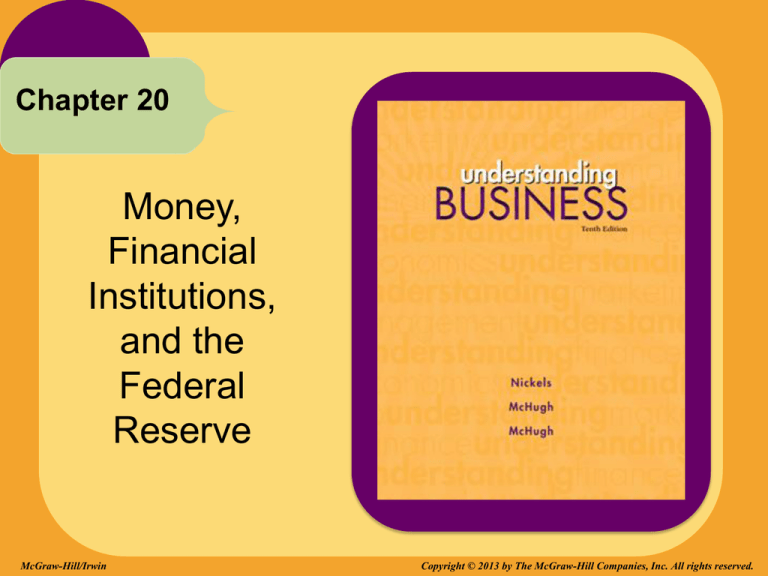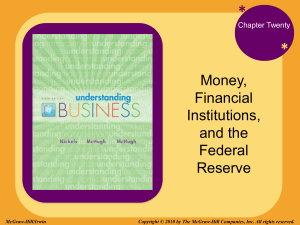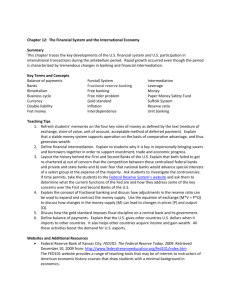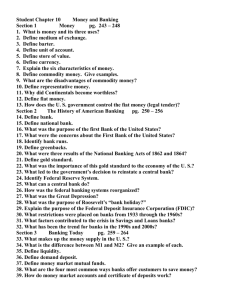
Chapter 20
Money,
Financial
Institutions,
and the
Federal
Reserve
McGraw-Hill/Irwin
Copyright © 2013 by The McGraw-Hill Companies, Inc. All rights reserved.
Chapter
Twenty
LEARNING GOALS
1. Explain what money is and what makes money
useful.
2. Describe how the Federal Reserve controls the
money supply.
3. Trace the history of banking and the Federal
Reserve System.
4. Classify the various institutions in the U.S. banking
system.
20-2
Chapter
Twenty
LEARNING GOALS
5. Briefly trace the causes of the banking crisis
starting in 2008 and explain how the government
protects your funds during such crises.
6. Describe how technology helps make banking
more efficient.
7. Evaluate the role and importance of international
banking, the World Bank, and the International
Monetary Fund.
20-3
Profile
BEN BERNANKE
Federal Reserve
• Bernanke is a former Princeton economics
professor.
• Former President George W. Bush appointed
Bernanke Chairman of the Federal Reserve in
2006.
• Almost every
factor related to
the economy is
influenced by the
decisions he
makes.
20-4
Chapter
Twenty
NAME that COMPANY
This bank-like store in Austin, Texas, was designed
to serve low-income clients who don’t have
traditional bank accounts. Customers pay a
one-time $10 fee that allows them to cash
checks and put the money onto debit cards.
Name that company!
20-5
What is
Money?
WHAT’S MONEY?
LG1
• Money -- Anything people generally accept as
payment for goods and services.
• Barter -- The direct
trading of goods or
services for other goods
or services.
20-6
What is
Money?
LG1
STANDARDS for a
USEFUL FORM of MONEY
• Portability
• Divisibility
• Stability
• Durability
• Uniqueness
20-7
What is the
Money
Supply?
The MONEY SUPPLY
LG2
• Money Supply -- The amount of money the Federal
Reserve makes available for people. The money
supply is referred to as:
- M1 -- Money that can be accessed quickly (coins,
paper money, travelers’ checks, etc.).
- M2 -- M1 + money that may take a little time to
obtain (savings accounts, mutual funds, etc.).
- M3 -- M2 + big deposits like institutional money
market funds.
20-8
What is the
Money
Supply?
LG2
NEW MONEY
Paper Money Printed in 2010 (In $ Billions)
Source: Bloomberg Businessweek, December 20, 2010.
20-9
What is the
Money
Supply?
LG2
HOW LONG DOES
PAPER MONEY LAST?
Bill
How Long it Lasts
$1
21 Months
$5
16 Months
$10
18 Months
$20
24 Months
$50
55 Months
$100
89 Months
Source: Federal Reserve, www.federalreserve.gov, accessed September 2011.
20-10
What is the
Money
Supply?
MONEY MILESTONES
LG2
Year
Milestone
1956
Congress set the minimum wage at $1 an hour
1960
$10 million presidential campaign by candidate Richard Nixon
1985
$100,000 bottle of wine sold at auction at Christie’s
1995
$1 million cost for a 30-second commercial during Super Bowl XXIX
2001
$10 movie ticket in New York
2004
$100 million Picasso painting sold at Sotheby’s
2007
$1 billion stadium built in London (Wembly)
20-11
What is the
Money
Supply?
LG2
MONEY FACTS
What You Might Not Know About What’s in Your Wallet
• In 2009, the U.S. printed 26,000,000 bills a day!
• Each penny costs 1.6¢ and each nickel costs 6¢
to make.
• The most-tracked bill on WheresGeorge.com has
travelled over 7,600 miles in 4 years!
• 2/3 of all U.S. $100 bills are outside the U.S.
• 90% of paper money has traces of cocaine!
Source: Fast Company, February 2011.
20-12
The Global
Exchange of
Money
EXCHANGING MONEY GLOBALLY
LG2
• Falling dollar value: The amount of goods and
services you can buy with a dollar decreases.
• Rising dollar value: The amount of goods and
services you can buy with a dollar increases.
• What makes the dollar fall or rise is the position
of the U.S. economy relative to other global
economies.
20-13
The Global
Exchange of
Money
LG2
The IMPACT of a
FALLING DOLLAR
• Overseas demand for U.S. products rise.
• A favorable exchange rate for U.S. companies
increases profits in foreign markets.
• U.S. tourism increases
which is good for hotels,
resorts, theme parks,
and retailers that serve
international travelers.
20-14
Basics About
the Federal
Reserve
LG2
FIVE MAJOR PARTS of the
FEDERAL RESERVE SYSTEM
1. The Board of Governors
2. The Federal Open
Market Committee
3. 12 Federal Reserve
Banks
4. 3 Advisory Councils
5. The member banks of
the system
20-15
Basics About
the Federal
Reserve
LG2
The 12 FEDERAL RESERVE
DISTRICT BANKS
20-16
Basics About
the Federal
Reserve
MANAGING the MONEY SUPPLY
LG2
• The Fed uses three basic tools:
1. Reserve Requirement -- A percentage of
commercial banks’ checking and savings accounts
they must keep in the bank or in non-interest-bearing
deposits at the local Federal Reserve district bank.
2. Open-Market Operations -- The buying and
selling of government bonds.
3. Discount Rate -- The interest rate the Fed charges
for loans to member banks.
20-17
The Federal
Reserve’s
CheckClearing Role
LG2
CHECK-CLEARING PROCESS
THROUGH the FEDERAL RESERVE
20-18
Progress
Assessment
PROGRESS ASSESSMENT
• What is money?
• What are the five characteristics of useful money?
• What is the money supply, and why is it important?
• How does the Federal Reserve control the money
supply?
• What are the major functions of the Federal
Reserve? What other functions does it perform?
20-19
The History of
Banking and the
Need for the
Fed
LG3
The ESTABLISHMENT of the
FEDERAL RESERVE SYSTEM
• A cash shortage problem in 1907 led to the
creation of the Federal Reserve System.
• Under the Federal
Reserve Act of 1913,
all federally chartered
banks had to join the
Federal Reserve.
20-20
The History of
Banking and the
Need for the
Fed
LARGEST BANK FAILURES
LG3
Bank
Year
Assets
Washington Mutual Bank
2008
$307 Billion
Continental Illinois NB&T
1984
$67 Billion
First Republic Bank Corp
1986
$49 Billion
American Savings & Loan Assn
1988
$45 Billion
IndyMac Bank
2008
$32 Billion
Colonial Bank
2009
$25 Billion
Source: http://www.FDIC.gov, accessed July 2011.
20-21
The U.S.
Banking
System
The U.S. BANKING SYSTEM
LG4
• Commercial banks
• Savings and loan
associations
• Credit unions
• Nonbanks
20-22
Commercial
Banks
COMMERCIAL BANKS
LG4
• Commercial Bank -- A profit-seeking organization
that receives deposits from individuals and
corporations in the form of checking and savings
accounts and uses those funds to make loans.
• A commercial bank has two types of customers:
1. Depositors
2. Borrowers
20-23
Services
Provided by
Commercial
Banks
LG4
COMMERICAL BANKS’
SERVICES
• Demand Deposit -- The technical name for a
checking account; money is available on demand
from the depositor.
• Time Deposit -- A savings account; a bank can
require a prior notice before you make a withdrawal.
• Certificate of Deposit -- A savings account that
earns interest, to be delivered on the certificate’s
maturity date.
20-24
BANKING on SOCIAL MEDIA
(Social Media in Business)
• Banks are using the Internet and social media to
communicate with Gen Y customers.
• Today 29 million Bank of America customers use
online banking.
• 6.5 million customers use smartphones for mobile
banking.
• Banks are following other companies leads and
embracing social media.
20-25
WHAT to TELL the TELLER
(Making Ethical Decisions)
• The bank teller mistakenly gives you $320
instead of the $300 you asked for.
• You bring the error to her attention, but she
disagrees she miscounted the money.
• You wonder whether to just keep the extra $20
even though you know her accounts will not
balance at the end of the day.
• What are your alternatives? What do you do?
20-26
Savings and
Loan
Associations
LG4
SAVINGS and
LOAN ASSOCIATIONS
• Savings and Loan Associations (S&Ls) -- A
financial institution that accepts both savings and
checking deposits and provides home mortgage
loans.
• Often known as thrift institutions because their
original purpose was to promote customer thrift
and home ownership.
20-27
Credit
Unions
CREDIT UNIONS
LG4
• Credit Unions -Nonprofit, member-owned
financial cooperatives that
offer the full variety of
banking services to their
members.
• As nonprofits, credit
unions enjoy an
exemption from federal
income taxes.
20-28
Other
Financial
Institutions
NONBANKS
LG4
• Nonbanks -- Financial institutions that accept no
deposits, but offer many of the services provided by
regular banks. Nonbanks include:
- Life insurance companies
- Pension funds
- Brokerage firms
- Commercial finance
companies
- Corporate financial
services
20-29
The RISE of the NONBANK
(Spotlight on Small Business)
• About ¼ of American households don’t have a
bank account.
• Mango Store is a bank-like facility in Austin,
Texas. Clients pay a one-time $10 fee that lets
them cash as many checks as they want by
putting the money onto debit cards.
• Mango hopes its customers will increase their
earning power and remain customers over time.
20-30
Other
Financial
Institutions
LG4
WHAT ATTRACTS CUSTOMERS
to ONLINE BANKING
• Free identity theft
protection
• Free credit score
monitoring
• Personal financial
management
• Instant messaging service
• Bank’s blog
Source: comScore, www.comscore.com, accessed September 2010.
20-31
Progress
Assessment
PROGRESS ASSESSMENT
• Why did the U.S. need a Federal Reserve Bank?
• What is the difference between a bank, a savings
and loan association, and a credit union?
• What is a consumer finance company?
20-32
Protecting
Your Funds
LG5
PROTECTING
DEPOSITORS’ MONEY
• The Federal Deposit Insurance Corporation
(FDIC) -- An independent agency of the U.S.
government that insures bank deposits up to
$250,000.
• The Savings Association Insurance Fund
(SAIF) -- Insures holders of accounts in savings and
loan associations.
• The National Credit Union Administration
(NCUA) -- Provides up to $250,000 coverage per
individual depositor per institution.
20-33
Using Technology
to Make Banking
More Efficient
LG6
TECHNOLOGICAL
ADVANCEMENTS in BANKING
• Electronic Funds Transfer
System -- Messages about a
transaction are sent from one
computer to another so funds
can be transferred quickly and
more economically.
• Debit Card -- Serves the
same function as a check; it
withdrawals funds from a
checking account.
20-34
Using Technology
to Make Banking
More Efficient
SMART CARDS
LG6
• Smart Card -- A
combination of a credit
card, debit card, phone
card, driver’s license, and
more.
20-35
International
Banking and
Banking Services
LG7
MAKING TRANSACTIONS in
OTHER COUNTRIES
• Letter of Credit -- A promise by the bank to pay the
seller a given amount if certain conditions are met.
• Banker’s Acceptance -- A promise the bank will
pay some specified amount at a particular time.
• Money exchange allows companies to go to a
bank and exchange currencies to use in a
particular country (i.e. dollars for euros).
20-36
The World Bank
and the
International
Monetary Fund
LG7
LEADING INSTITUTIONS in
INTERNATIONAL BANKING
• World Bank -- Lends most of its
money to less-developed nations to
improve their productivity and help
raise standards of living and quality
of life.
• International Monetary Fund
(IMF) -- Fosters cooperative
monetary policies that stabilize the
exchange of one national currency
for another. About 185 countries are
a part of the IMF.
20-37
NEW ISSUES FACING the
WORLD BANK and the IMF
(Reaching Beyond Our Borders)
• A debt crisis in Europe; Japan trying to recover from its
earthquake and tsunami; major disruptions in the
Middle East; China and Brazil are having problems with
high inflation; and rising food prices are happening all
over the planet.
• Poorer nations are having a particularly hard time
because of the high food prices.
• The IMF and the World Bank are both trying to come up
with answers to the global issues that have become
very serious.
20-38
Progress
Assessment
PROGRESS ASSESSMENT
• What are some of the causes for the banking
crisis beginning in 2008?
• What is the role of the FDIC?
• How does a debit card differ from a credit card?
• What is the World Bank and what does it do?
• What is the IMF and what does it do?
20-39








